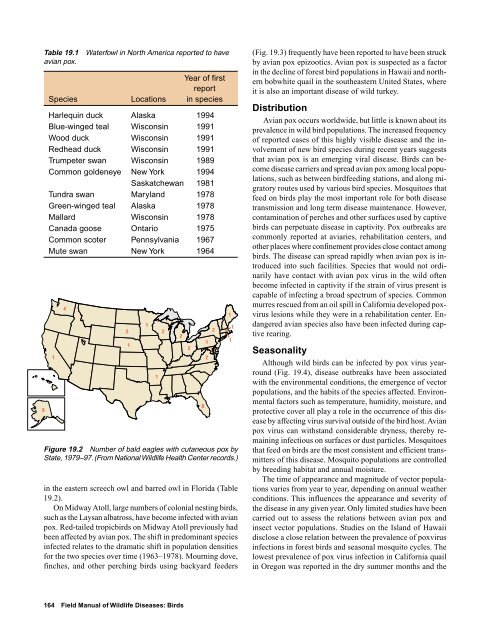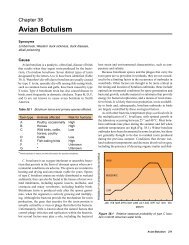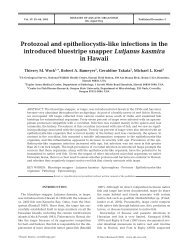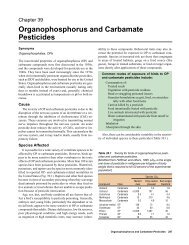Chapter 19 Avian Pox - National Wildlife Health Center
Chapter 19 Avian Pox - National Wildlife Health Center
Chapter 19 Avian Pox - National Wildlife Health Center
Create successful ePaper yourself
Turn your PDF publications into a flip-book with our unique Google optimized e-Paper software.
Table <strong>19</strong>.1<br />
avian pox.<br />
9<br />
Waterfowl in North America reported to have<br />
Year of first<br />
report<br />
Species Locations in species<br />
Harlequin duck Alaska <strong>19</strong>94<br />
Blue-winged teal Wisconsin <strong>19</strong>91<br />
Wood duck Wisconsin <strong>19</strong>91<br />
Redhead duck Wisconsin <strong>19</strong>91<br />
Trumpeter swan Wisconsin <strong>19</strong>89<br />
Common goldeneye New York <strong>19</strong>94<br />
Saskatchewan <strong>19</strong>81<br />
Tundra swan Maryland <strong>19</strong>78<br />
Green-winged teal Alaska <strong>19</strong>78<br />
Mallard Wisconsin <strong>19</strong>78<br />
Canada goose Ontario <strong>19</strong>75<br />
Common scoter Pennsylvania <strong>19</strong>67<br />
Mute swan New York <strong>19</strong>64<br />
1<br />
4<br />
2<br />
1<br />
1<br />
1<br />
2<br />
2<br />
2<br />
8<br />
1<br />
1<br />
2<br />
1 1<br />
1<br />
Figure <strong>19</strong>.2 Number of bald eagles with cutaneous pox by<br />
State, <strong>19</strong>79–97. (From <strong>National</strong> <strong>Wildlife</strong> <strong>Health</strong> <strong>Center</strong> records.)<br />
in the eastern screech owl and barred owl in Florida (Table<br />
<strong>19</strong>.2).<br />
On Midway Atoll, large numbers of colonial nesting birds,<br />
such as the Laysan albatross, have become infected with avian<br />
pox. Red-tailed tropicbirds on Midway Atoll previously had<br />
been affected by avian pox. The shift in predominant species<br />
infected relates to the dramatic shift in population densities<br />
for the two species over time (<strong>19</strong>63–<strong>19</strong>78). Mourning dove,<br />
finches, and other perching birds using backyard feeders<br />
2<br />
(Fig. <strong>19</strong>.3) frequently have been reported to have been struck<br />
by avian pox epizootics. <strong>Avian</strong> pox is suspected as a factor<br />
in the decline of forest bird populations in Hawaii and northern<br />
bobwhite quail in the southeastern United States, where<br />
it is also an important disease of wild turkey.<br />
Distribution<br />
<strong>Avian</strong> pox occurs worldwide, but little is known about its<br />
prevalence in wild bird populations. The increased frequency<br />
of reported cases of this highly visible disease and the involvement<br />
of new bird species during recent years suggests<br />
that avian pox is an emerging viral disease. Birds can become<br />
disease carriers and spread avian pox among local populations,<br />
such as between birdfeeding stations, and along migratory<br />
routes used by various bird species. Mosquitoes that<br />
feed on birds play the most important role for both disease<br />
transmission and long term disease maintenance. However,<br />
contamination of perches and other surfaces used by captive<br />
birds can perpetuate disease in captivity. <strong>Pox</strong> outbreaks are<br />
commonly reported at aviaries, rehabilitation centers, and<br />
other places where confinement provides close contact among<br />
birds. The disease can spread rapidly when avian pox is introduced<br />
into such facilities. Species that would not ordinarily<br />
have contact with avian pox virus in the wild often<br />
become infected in captivity if the strain of virus present is<br />
capable of infecting a broad spectrum of species. Common<br />
murres rescued from an oil spill in California developed poxvirus<br />
lesions while they were in a rehabilitation center. Endangered<br />
avian species also have been infected during captive<br />
rearing.<br />
Seasonality<br />
Although wild birds can be infected by pox virus yearround<br />
(Fig. <strong>19</strong>.4), disease outbreaks have been associated<br />
with the environmental conditions, the emergence of vector<br />
populations, and the habits of the species affected. Environmental<br />
factors such as temperature, humidity, moisture, and<br />
protective cover all play a role in the occurrence of this disease<br />
by affecting virus survival outside of the bird host. <strong>Avian</strong><br />
pox virus can withstand considerable dryness, thereby remaining<br />
infectious on surfaces or dust particles. Mosquitoes<br />
that feed on birds are the most consistent and efficient transmitters<br />
of this disease. Mosquito populations are controlled<br />
by breeding habitat and annual moisture.<br />
The time of appearance and magnitude of vector populations<br />
varies from year to year, depending on annual weather<br />
conditions. This influences the appearance and severity of<br />
the disease in any given year. Only limited studies have been<br />
carried out to assess the relations between avian pox and<br />
insect vector populations. Studies on the Island of Hawaii<br />
disclose a close relation between the prevalence of poxvirus<br />
infections in forest birds and seasonal mosquito cycles. The<br />
lowest prevalence of pox virus infection in California quail<br />
in Oregon was reported in the dry summer months and the<br />
164 Field Manual of <strong>Wildlife</strong> Diseases: Birds
















